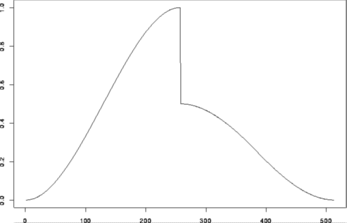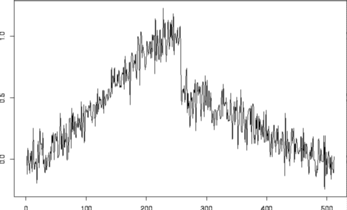WaveThresh
Help
threshold.wp
Threshold wavelet packet decomposition object
DESCRIPTION
This function provides various ways to threshold a
wp class object.
USAGE
threshold.wp(wp, levels = 3:(wd$nlevels - 1), dev = madmad,
policy = "universal", value = 0, by.level = F, type = "soft",
verbose = F, return.threshold = F, cvtol = 0.01, cvnorm = l2norm,
add.history = T)
REQUIRED ARGUMENTS
- wp
- The wavelet packet object that you wish to threshold.
OPTIONAL ARGUMENTS
- levels
- a vector of integers which determines which scale levels are thresholded
in the decomposition. Each integer in the vector must refer to a valid
level in the wp object supplied. This is usually
any integer from 0 to
nlevels(wp)-1 inclusive.
Only the levels in this vector contribute to the computation of the
threshold and its application.
- dev
- this argument supplies the function to be used to compute the
spread of the absolute values coefficients. The function supplied must
return a value of spread on the variance scale (i.e. not standard deviation)
such as the
var() function. A popular, useful and
robust alternative is the madmad function.
- policy
- selects the technique by which the threshold value is selected. Each
policy corresponds to a method in the literature. At present the
different policies are:
"universal" and
"mannum".
The policies are described in detail below.
- value
- This argument conveys the user supplied threshold. If the
policy="manual"
then value is the actual
threshold value.
- by.level
- If FALSE then a global threshold is computed on and applied to all
scale levels defined in
levels. If TRUE a threshold
is computed and applied separately to each scale level.
- type
- determines the type of thresholding this can be
"hard"
or "soft".
- verbose
- if TRUE then the function prints out informative messages as it progresses.
- return.threshold
- If this option is TRUE then the actual value of the threshold
is returned. If this option is FALSE then a thresholded version of the
input is returned.
- cvtol
- Not used, but reserved for future use.
- cvnorm
- Not used, but reserved for future use.
- add.history
- if
T then a history statement is added to the object for
displaying.
VALUE
An object of class wp. This object contains the
thresholded wavelet coefficients. Note that if the
return.threshold option is set to TRUE then the threshold
values will be returned rather than the thresholded object.
SIDE EFFECTS
None
DETAILS
This function thresholds or shrinks wavelet coefficients stored in
a wp object and returns the coefficients
in a modified wp object.
See the seminal papers by
Donoho and Johnstone for
explanations about thresholding.
For a gentle introduction to wavelet thresholding (or shrinkage
as it is sometimes called) see
Nason and Silverman, 1994.
For more details on each technique
see the descriptions of each method below
The basic idea of thresholding is very simple. In a signal plus noise
model the wavelet packet transform of signal is very sparse, the wavelet
packet
transform of noise is not (in particular, if the noise is iid Gaussian
then so if the noise contained in the wavelet packet coefficients [within a
particular orthogonal basis chosen from the packet tree. In general, the
noise is not independent]). Thus since
the signal gets concentrated in the wavelet coefficients and the noise
remains "spread" out it is "easy" to separate the signal from noise
by keeping large coefficients (which correspond to signal) and
delete the small ones (which correspond to noise). However, one has
to have some idea of the noise level (computed using the dev
option in threshold functions). If the noise level is very large then
it is possible, as usual, that no signal "sticks up" above the noise.
There are many components to a successful thresholding procedure. Some
components have a larger effect than others but the effect is not the
same in all practical data situations. Here we give some rough
practical guidance, although you must refer to the papers below
when using a particular technique. You cannot expect to
get excellent performance on all signals unless you fully understand
the rationale and limitations of each method below. I am
not in favour of the "black-box" approach. The thresholding functions
of WaveThresh3 are not a black box: experience and judgement are required!
Some issues to watch for:
- levels
- The default of
levels = 3:(wd$nlevels - 1) for the
levels option most certainly does not work globally for
all data problems and situations. The level at which thresholding begins
(i.e. the given threshold and finer scale wavelets) is called the
primary resolution and is unique to a particular problem.
In some ways choice of the primary resolution is very similar to choosing
the bandwidth in kernel regression albeit on a logarithmic scale.
See Hall and Patil, (1995) and
Hall and Nason (1997) for more information.
For each data problem you need to work out which is the best
primary resolution. This can be done by gaining experience at what works
best, or using prior knowledge. It is possible to "automatically" choose
a "best" primary resolution using cross-validation (but not in WaveThresh).
Secondly the levels argument computes and applies the threshold at the
levels specified in the levels argument. It does this for
all the levels specified. Sometimes, in wavelet shrinkage, the threshold
is computed using only the finest scale coefficients (or more precisely
the estimate of the overall noise level). If you want your threshold
variance estimate only to use the finest scale coefficients (e.g.
with universal thresholding) then you will have to apply the
threshold.wp function twice. Once (with levels set equal to
nlevels(wd)-1 and with
return.threshold=TRUE to return the threshold computed on
the finest scale and then apply the threshold function with the
manual option supplying the value of the previously computed
threshold as the value options.
- by.level
- for a wd object which has come from data with
noise that is correlated then you should have a threshold computed for
each resolution level. This is true for wavelet packet objects as well in
a certain sense.
See the paper by
Johnstone and Silverman, 1997.
This section gives a brief description of the different thresholding
policies available. For further details see the associated papers.
If there is no paper available then a small description is provided here.
More than one policy may be good for problem, so experiment! They
are arranged here in alphabetical order:
- universal
- See Donoho and Johnstone, 1995.
RELEASE
Version 3.6 Copyright Guy Nason and others 1997
SEE ALSO
wp,
wp object,
InvBasis,
MaNoVe,
threshold.
EXAMPLES
#
# Generate some test data
#
test.data <- example.1()$y
tsplot(test.data)
 #
# Generate some noisy data
#
ynoise <- test.data + rnorm(512, sd=0.1)
#
# Plot it
#
tsplot(ynoise)
#
# Generate some noisy data
#
ynoise <- test.data + rnorm(512, sd=0.1)
#
# Plot it
#
tsplot(ynoise)
 #
# Now take the discrete wavelet packet transform
# N.b. I have no idea if the default wavelets here are appropriate for
# this particular example.
#
ynwp <- wp(ynoise)
#
# Now do thresholding. We'll use a universal policy,
# and madmad deviance estimate on the finest
# coefficients and return the threshold. We'll also get it to be verbose
# so we can watch the process.
#
ynwpT1 <- threshold(ynwp, policy="universal", dev=madmad)
#
# This is just another wp object. Is it sensible?
# Probably not as we have just thresholded the scaling function coefficients
# as well. So the threshold might be more sensibly computed on the wavelet
# coefficients at the finest scale and then this threshold applied to the
# whole wavelet tree??
#
# Now take the discrete wavelet packet transform
# N.b. I have no idea if the default wavelets here are appropriate for
# this particular example.
#
ynwp <- wp(ynoise)
#
# Now do thresholding. We'll use a universal policy,
# and madmad deviance estimate on the finest
# coefficients and return the threshold. We'll also get it to be verbose
# so we can watch the process.
#
ynwpT1 <- threshold(ynwp, policy="universal", dev=madmad)
#
# This is just another wp object. Is it sensible?
# Probably not as we have just thresholded the scaling function coefficients
# as well. So the threshold might be more sensibly computed on the wavelet
# coefficients at the finest scale and then this threshold applied to the
# whole wavelet tree??
 #
# Generate some noisy data
#
ynoise <- test.data + rnorm(512, sd=0.1)
#
# Plot it
#
tsplot(ynoise)
#
# Generate some noisy data
#
ynoise <- test.data + rnorm(512, sd=0.1)
#
# Plot it
#
tsplot(ynoise)
 #
# Now take the discrete wavelet packet transform
# N.b. I have no idea if the default wavelets here are appropriate for
# this particular example.
#
ynwp <- wp(ynoise)
#
# Now do thresholding. We'll use a universal policy,
# and madmad deviance estimate on the finest
# coefficients and return the threshold. We'll also get it to be verbose
# so we can watch the process.
#
ynwpT1 <- threshold(ynwp, policy="universal", dev=madmad)
#
# This is just another wp object. Is it sensible?
# Probably not as we have just thresholded the scaling function coefficients
# as well. So the threshold might be more sensibly computed on the wavelet
# coefficients at the finest scale and then this threshold applied to the
# whole wavelet tree??
#
# Now take the discrete wavelet packet transform
# N.b. I have no idea if the default wavelets here are appropriate for
# this particular example.
#
ynwp <- wp(ynoise)
#
# Now do thresholding. We'll use a universal policy,
# and madmad deviance estimate on the finest
# coefficients and return the threshold. We'll also get it to be verbose
# so we can watch the process.
#
ynwpT1 <- threshold(ynwp, policy="universal", dev=madmad)
#
# This is just another wp object. Is it sensible?
# Probably not as we have just thresholded the scaling function coefficients
# as well. So the threshold might be more sensibly computed on the wavelet
# coefficients at the finest scale and then this threshold applied to the
# whole wavelet tree??